Behind the
Numbers


- California has the 6th largest economy in the world and thelargest GDP of any state, yet ranks near the bottom in nearly every measure of school funding or school staffing.
- 45th in percentage of taxable income spent on education
Percent of total taxable income spent on education
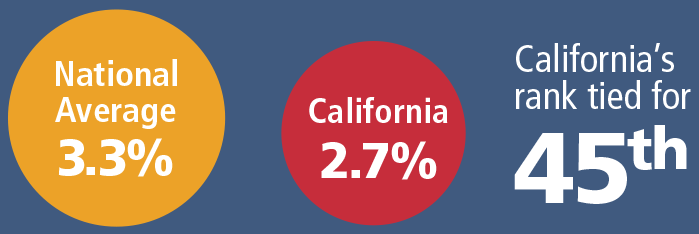
Source: Ed Week (2014)
- The state has barely restored the funding levels of schools to what they were before the great recession, yet in nearly all communities these gains are being eroded by increasing costs in health care, pensions, and utility costs that threaten educational programs and challenge school districts and county offices of education to stay financially viable.
- California’s inadequate school funding hurts our students, undermines our communities, threatens our prosperity, and dims the prospects of future generations.
- If we want to prepare our students for an increasingly competitive, technology-driven global economy, we must invest at a level necessary to support student success.

in per-pupil funding
Per-pupil funding

$1,961 funding gap
Source: California Budget & Policy Center through 2015-16

in pupil-teacher ratios
Pupils per teacher

135,041 teachers needed to close the gap
Source: NEA (2015-16)

in pupil-staff ratio
All staff: students per staff member

213,711 staff needed to close the gap
Source: NCES (2014-2015)

- If the state funded schools at just the national average, that would increase funding by $1,961 per pupil. For a classroom of 25 students, that’s an additional $49,025 for student support services (counselors, social workers, wellness centers), parent and community engagement, support for English learners, intervention programs, instructional support staff, class size reduction, CTE, and expanded offerings in the arts and other extracurriculars.
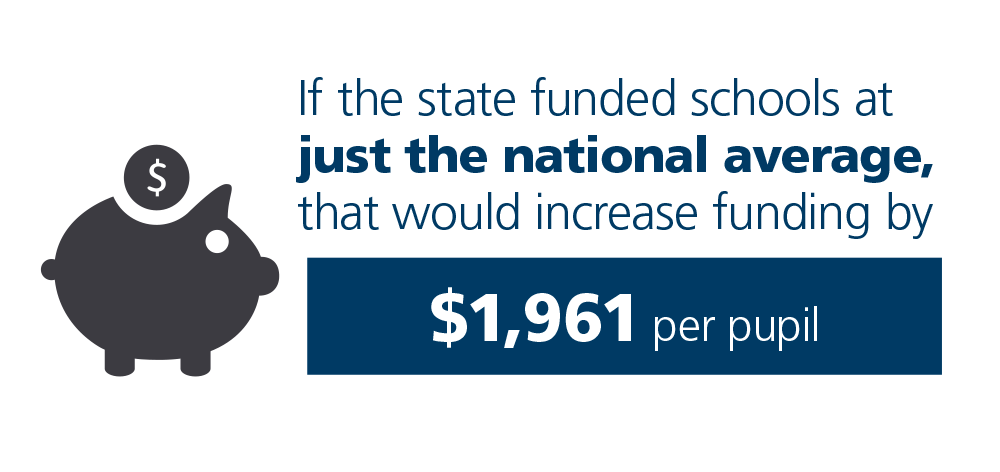
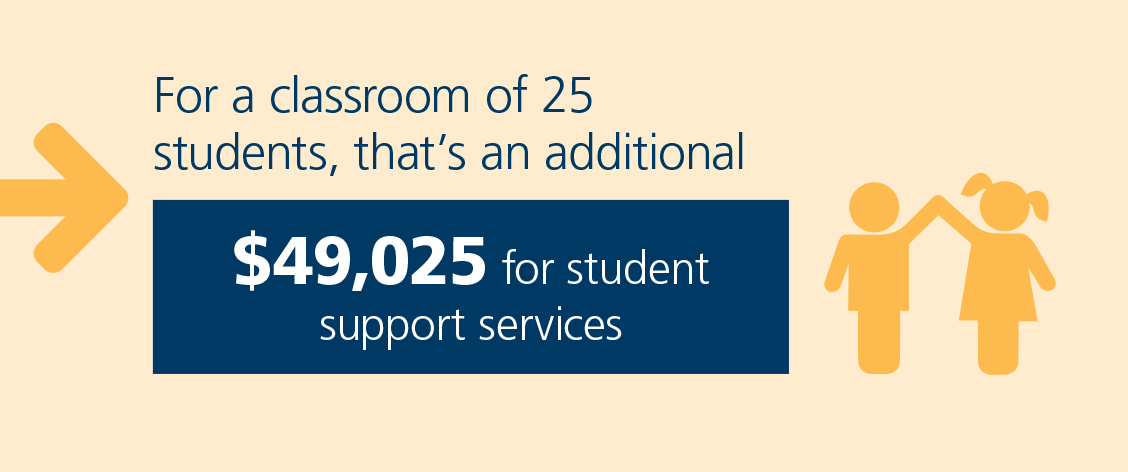
Source: California Budget & Policy Center through 2015-16
With an additional $1,961 per student, a school with 500 students would have $980,500 in additional revenue. This would allow the school many options to begin to address inequities: ![]()
- Improve College and Career Counseling by providing a college and career counselor for every 250 students (recommended by the American School Counselor Association). This will ensure that all students are on track to graduate, meet A-G requirements, and have a robust plan for what to do post high school graduation.
Cost: $159,948 for two counselors.1
- Engage Parents by having teachers conduct home visits and having a parent coordinator organize educational classes for parents to learn about how they can best support their children’s education.
Cost: $87,474 to provide a stipend for teachers to conduct at least a one-hour home visit per student (assuming a cost of $15 per hour) and a parent coordinator.2
- Ensure Advanced Placement Success by placing all students in an Advanced Placement course, paying for test fees, and incorporating student supports, including tutoring, to master and practice the content. Supports can also incorporate AP preparation during summer school (see section on expanding summer learning).
Cost: $89,500 to provide each student with one AP test fee ($94) and an average of one hour of tutoring from a certificated teacher ($85).
- Provide a Well-Rounded Education by supporting time for arts, physical activity, civic engagement and other topics that provide students with a well-rounded education. Funding will support part-time teachers in these diverse subject areas.
Cost: $159,948 for four half-time teachers3 in the areas of art, music, physical education, and civics.
- Expand Summer Learning to ensure that all students are enrolled in a summer program that offers a rigorous curriculum that is centered on a relevant theme, coordinated by an expert teacher, and offers opportunities for hands-on learning that truly immerses students in the subject matter.
Cost: $464,425 to provide each student with a five-week summer program ($185.77 per student per week of summer learning4).
- Expand Preschool to ensure that all students are enrolled in a high-quality preschool program with a qualified teacher that supports the development of cognitive, motor, and other skills that will allow students to be successful once they enter kindergarten.
Cost: $690,201 for 81 students to enroll in a full-day, yearround program led by a teacher with a bachelor’s degree in early childhood education ($8,521 per student).5 A total of $4.3 million would be required to provide quality preschool to all 500 students.
- All staff are assumed to have a $79,974 cost to the school. This is based on a $66,645 mid-point salary for certificated staff during the 2015-16 school year, plus an additional 20% in benefits. See http://bit.ly/2jmYHcw
- See endnote 1
- See endnote 1
- Estimate by Summer Matters. See http://bit.ly/2widdwH
- See estimates at http://bit.ly/2uQwo0j
- California has one of the worst teacher-pupil ratios in the nation and some of the lowest overall staffing levels in the country.
11.7
2,141
382
97.6
822
8,096
8.1
750
298
67.8
491
1,109
3.6
1,391
85
29.8
331
6,981
238,781
5,469
4,695
28,456
5,186
4,909
48th
47th
44th
46th
49th
50th
- The problems posed by California’s dismal school funding levels are compounded by the high level of student need and the state’s high cost of living: 58% of California’s public school students are eligible for free or reduced-price lunch — above the national average of 52%.
Free or reduced-price lunch eligible


Source: California Dept. of Education Student Poverty FRPM Data (Mar 2016)
- California also has the nation’s highest percentage of English learner students at 23% — more than twice the national average of 9%.
English learners (% of enrollment)


Source: NCES (2013-14)
- LCFF is a step forward philosophically because it supports equity by directing more money to students with higher need. But redistribution is not a solution when the overall funding pie is much too small. California is a wealthy state with high incomes and a large, healthy economy that has chosen to invest more in other parts of government than it invests in schools.
- Funding gaps began when the state took over school funding in the 1970s with the Serrano v. Priest decision and grew steadily post Proposition 13.
High spending on government, low spending on schools
State and local government expenditures per $1,000 personal income
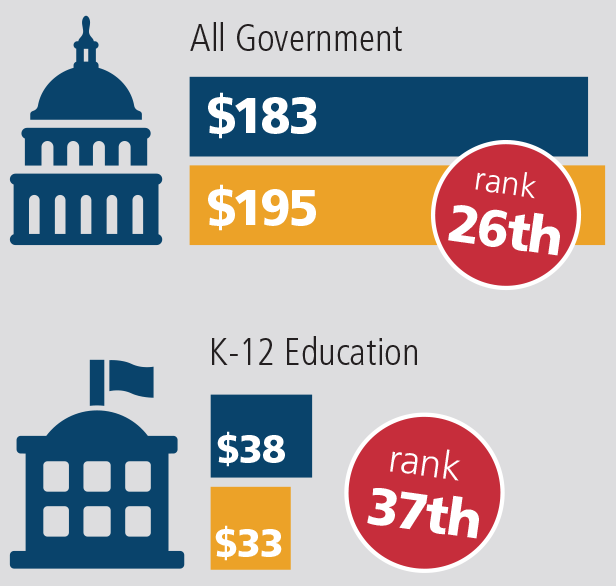

Source: NEA (2014)
Funding gap with national average
(NCES Per-Pupil Spending Constant $)

- The urgency of investment in public schools is only growing as:
- The Proposition 98 guarantee has not kept pace with the needs of public schools for our students and our state to remain competitive.
- Employer pension contribution costs will more than double over the next five years.
- Health care, utility, transportation, and special education costs continue to skyrocket.
- Unfunded mandates are introduced annually.
- The next recession grows closer.
PERS/STRS Employer Costs
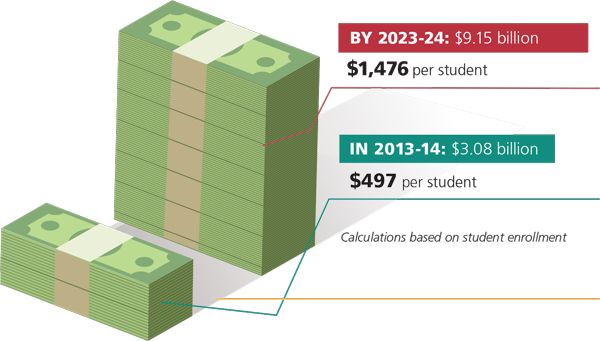
- California has consistently underfunded public education while widening its scope, adding new requirements, and raising the standards for what constitutes 21st-century learning. As a result, our schools lack the resources of those in poorer sections of the country as well as the resources needed to meet the state’s goals for students.
Districts and County Offices of Education are doing more with less, but it’s not enough. If California is serious about providing all its children with a high-quality education, we need to get serious about full and fair funding for public schools.
Districts and County Offices of Education are doing more with less, but it’s not enough. If California is serious about providing all its children with a high-quality education, we need to get serious about full and fair funding for public schools.